Marine resources - Eastern Central Atlantic|
| Fact Sheet Title Fact Sheet |
| | | Marine resources - Eastern Central Atlantic |
 | Toutes Ressources dans la zone Atlantique Centre Est (Zone Statistique FAO 34) |
| | Data Ownership | | This document owned by Food and Agriculture Organization (FAO), provided and maintained by Marine and Inland Fisheries Branch (FIRF) , is part of FAO Global Marine Fishery Resource Reports data collection. |
| | ident Block | ident Block | | | | Species List: All aquatic species | |
|
| ident Block Marine resources - Eastern Central Atlantic Aq Res Ident Aq Res Ident Aq Res Ident | fao Major |
|---|
| 34 | Atlantic, Eastern Central |
|---|
|
|
|
|
| | Aq Res | Biological Stock: Biological Stock Value: Regional
Management Unit: Management Unit Reference Year: 2009
|
| Considered a management unit: An aquatic resource or fishery is declared as [Fishery] Management Unit if it is effectively the focus for the application of selected management methods and measures, within the broader framework of a management system. According to the FAO Glossary for Responsible Fishing, "a Fishery Management Unit (FMU) is a fishery or a portion of a fishery identified in a Fishery Management Plan (FMP) relevant to the FMP's management objectives." FMU's may be organised around fisheries biological, geographic, economic, technical, social or ecological dimensions , and the makeup and attribute of a fishery management unit depends mainly on the FMP's management objectives. |
| Jurisdictional distribution: Jurisdictional qualifier (e.g. "shared", "shared - highly migratory") of the aquatic resource related with its spatial distribution. |
| Environmental group: Classification of the aquatic resource according to the environmental group (e.g. pelagic invertebrate, or demersal fish) to which the species belong. |
| | | | | | Aq Res State Trend To access all FIRMS State and Trend summaries available for this Area, please look at: Status and Trend Summaries (extracted from reports)This review of the status of stocks is principally based on the results of assessments of the state of the major fisheries resources undertaken by the working groups of the CECAF between 2008 and 2011. The working groups assessed the state of the major fisheries resources in the region in 2008–2011. These assessments and the recommendations of the Scientific Sub-Committee of the CECAF (Accra, Ghana, 7–9 September 2011) form the basis of this section. The status of commercial species is shown in Table D4. Fisheries are important in the CECAF region as sources of food and income, and as such support livelihoods at different levels. Most of the commercially important stocks in the region are classified as being fully exploited or overexploited, with few stocks considered non-fully exploited. In general, the situation has been more severe for the valuable demersal species, with a larger number of overexploited stocks compared with the pelagic species. Pelagic species have in general been considered fully exploited, although some important stocks have been classified as overexploited in recent assessments (e.g. round sardinella in Northwest Africa and in the Gulf of Guinea). It is noteworthy that some of the deepwater shrimp stocks in the northern part of Area 34 seem to have improved and are now considered non-fully exploited. Northern areasMany of the commercially important demersal resources of Northwest Africa are heavily exploited. Hakes and other finfish resources, Northern areas With regard to finfish, hake (Merluccius merluccius) on the Moroccan continental shelf are considered overexploited. Of the other finfish resources assessed, the stock of whitegrouper (Epinephelus aeneus) was found to be at particular risk, and immediate action is needed (FAO/CECAF, forthcoming a, forthcoming b). The stocks of other important finfish species, such as the red pandora (Pagellus bellottii), axillary seabream (Pagellus acarne) and blue-spotted seabream (Pagrus caeruleostictus), are also overexploited, but not as seriously overexploited as the white grouper. Common octopus, Northern areas Three stocks of common octopus (Octopus vulgaris) are exploited by the Northwest African cephalopod fisheries, namely Dakhla, Cap Blanc and Senegal and Gambia stocks. All three are considered overexploited, with recent catches about 43 000 tonnes for the Dahkla stock, 32 000 tonnes for the Cap Blanc stock and 6 500 tonnes for the Senegal and Gambia stock (FAO/CECAF, forthcoming b). The Dakhla stock is currently managed under a management plan based on a combination of a seasonally determined TAC regime and several other measures aiming at reducing fishing pressure (fishing licences, closed seasons and minimum size). For the Cap Blanc stock, the main management measures include: closed seasons (September–October and two months in spring), freeze on licences, and minimum mesh and size restrictions as well as no-trawl zones in shallow waters less than 20 m deep (general restriction). Other cephalopods, Northern areas The exploitation of other species of cephalopods, such as squids (Loligo vulgaris) and cuttlefish (Sepia officinalis), is less intense compared with that of octopus, and their catches accounted for 33 percent of the cephalopods landed in 2008 (FAO/CECAF, forthcoming b). Management measures taken in the Moroccan EEZ, and applied to all demersal fisheries, include a two-month closed season and a reduction in the number of non-Moroccan vessels operating in the region. In Mauritania, since 2002, two closed seasons are in place for a total duration of four months, two months in spring and two months in autumn.
Deep-water rose shrimp and shallow-water shrimp, Northern areas The 2008 catches of deep-water rose shrimp and shallow-water southern pink shrimp (Penaeus notialis) in the northern CECAF area were about 17 000 tonnes (data from the 2010 Working Group on Demersal Stocks). The stocks of deep-water rose shrimp in Morocco and the shallow-water shrimp in Mauritania, Senegal and the Gambia are overexploited. However, the latest assessment has indicated an improvement in the status of the deep-water rose shrimp in the Gambia, Mauritania and Senegal. These stocks are now considered non-fully exploited (FAO/CECAF, 2011b). Small pelagic, Northern areas The biomasses of the large stocks of small pelagics in the northern CECAF area – sardine (Sardina pilchardus), sardinella (Sardinella aurita and Sardinella maderensis), chub mackerel (Scomber japonicus) and horse mackerel (Trachurus spp.) – are highly variable as they are strongly influenced by environmental fluctuations. From 1995 to 2006 these stocks were regularly monitored by acoustic surveys carried out by the Norwegian research vessel Dr. Fridtjof Nansen. Since then, the responsibility for the regional monitoring of these stocks has been with the national research institutions using their national research vessels. However, in recent years, only the research vessels of Mauritania and Morocco have been able to keep up the monitoring work. This has meant that estimates have had to be made for the size of the populations in the southern region (FAO, 2011a, 2011b). Sardine, Northern areas The sardine (S. pilchardus) biomass estimated by acoustic methods increased over the years 1997–2005 from a level of about 1.0 million tonnes to a record high biomass of about 8.0 million tonnes in 2005, before dropping to 3.6 million tonnes in 2006. Since then, biomass estimates have been between 4.4 and 5.9 million tonnes (FAO, 2011b).
For Sardinella aurita, an overall general decreasing trend in the acoustic estimates from 2.1 million tonnes in 1999 to about 1.0 million tonnes in 2007 was observed. Estimates had to be made for the southern part of the Sardinella distribution for the two subsequent years (2008, 2009). These years resulted in the largest biomass estimates of 2.0 million tonnes in 2008 and 2.9 million tonnes in 2009. Despite this trend, this stock is considered overexploited, considering other information from the fishery. The estimated biomass of S. maderensis fluctuated with an average of 1.2 million tonnes for the period 1995 to 2002. Since then, the biomass increased to 2.5 million tonnes in 2004 and then fluctuated between 0.6 million tonnes and 2008 to 2.5 million tonnes in 2006. In 2009, the estimated biomass of S. maderensis was 1.7 million tonnes. Of the other species, the biomass estimated by acoustic surveys for mackerel, horse mackerel and other small pelagics in the region between Morocco and Senegal was about 5 million tonnes in the November–December surveys carried out between 1995 and 2009 (FAO, 2011b). The Working Group on the Assessment of Small Pelagic Fish off Northwest Africa has been meeting on an annual basis since 2001. The latest working group recommended that the combined catch of small pelagics in Northwest Africa should not be increased above the average of the last five years, excluding the sardine in Zone C (Sardina pilchardus) (FAO, 2011b). The different species groups of sardinella, horse mackerels and mackerels are intensively exploited and some species are considered overexploited (FAO, 2011c). Cape VerdeAround Cape Verde, the national fleet has landed an annual average of 8 870 tonnes of all marine species for the last five years (2005–09). In the same period, the international fleet has reported a mean annual catch of 5 000 tonnes (Tariche, personal communications, 2011). The artisanal landings represented an average of 49 percent of the national catch.
The most important fisheries are those for pelagic fishes, with a mean estimated catch of 4 400 tonnes (49 percent of the total), and those for tunas and tuna-like species, with a mean estimated catch of 2 800 tonnes (31 percent of the total). Pelagic fishes, Cape Verde The most important fisheries are those for pelagic fishes, with a mean estimated catch of 4 400 tonnes (49 percent of the total), and those for tunas and tuna-like species, with a mean estimated catch of 2 800 tonnes (31 percent of the total). Coastal spiny lobsters and pink (deep-water) lobster, Cape Verde The coastal spiny lobsters (Panulirus regius, P. echinatus and Scyllarides lattus) as well as pink (deep-water) lobster (Palinurus charlestoni) are considered to be overexploited, and a freeze of fishing effort has been recommended. With the exception of the deepwater shrimp Plesionika edwardsii, there are no recent assessments of the state of the fishery resources in Cape Verde. Carvalho, Morais and Nascimento (1999) provide an overview of assessments carried out in the 1990s. An assessment carried out by the CECAF in 2005 indicated that the stock of African hind (Cephalopholis taeniops) was fully exploited. Southern areasIn general, multispecies fisheries are common in the southern CECAF area (south of Senegal). Artisanal fisheries are important, although differences in types of fisheries and target species are observed along the coast. Coastal fishes, Southern areas The continental shelf is characterized by coastal fish assemblages with a range of species groups including croakers, various grunts (including the big-eye grunt, Brachydeuterus auritus), catfishes, groupers and snappers. On the outer shelf, there are several seabreams including Dentex species and other species of the slope community.
Of the species assessed by regional working groups, croakers (Pseudotolithus spp.) contributed about 26 percent of the catches in 2006 (data from FAO/CECAF Demersal South Working Group 2008). Shrimp species, Southern areas Shrimps are also important throughout the southern region, principally in the nutrient-rich estuarine and inshore areas. The white shrimp resources off Nigeria and Cameroon are fished exclusively by artisanal fisheries, while the southern pink shrimp are exploited by different types of fleets. Demersal resources, Southern areas Trawl surveys carried out on the Western Gulf of Guinea continental shelf by the Dr. Fridtjof Nansen have shown that the estimated biomass of demersal resources varied between 1999 and 2006. For the surveys since 2002, the estimated biomass for the valuable demersal resources varied between 25 000 tonnes and 35 000 tonnes, with the 2006 biomass estimate being somewhat lower than that of 2005 (Mehl, Olsen and Bannerman, 2006). These demersal resources were found to be either fully exploited or overexploited (based on data from the 2010 Working Group on Demersal Stocks). Owing to inconsistencies in the input data, the CECAF Demersal Working Group 2008 recommended that a precautionary approach that avoided any increase in fishing effort should be adopted for all the demersal species in the region south of Guinea-Bissau. Cephalopods, Southern areas In Guinea, Guinea-Bissau and Ghana important catches of cephalopods (mainly cuttlefish) are also reported. The exploitation rate applied to cuttlefish stocks in Guinea and Ghana has been increasing since the 1990s and the stocks were considered to be overexploited (FAO/CECAF, forthcoming c). Small pelagic species, Southern areas Small pelagic species are found throughout the region, but are particularly abundant in the coastal upwelling areas, such as off Côte d’Ivoire and Ghana, further south off Gabon, the Congo, the Democratic Republic of Congo and extending down to Angola. Small pelagic resources are exploited mainly by artisanal and semi-industrial purse seine in Côte d’Ivoire, Ghana, Togo and Benin. In Nigeria and Cameroon, they are caught exclusively by small-scale fisheries and by the industrial and artisanal fisheries in Gabon, the Republic of Congo and Angola.
In the Western Gulf of Guinea (Côte d’Ivoire, Ghana, Togo and Benin), small pelagic species such as Sardinella species, mackerels and anchovies are important, but their catches vary widely. This further complicates the management of the fisheries exploiting them. The most recent assessments show that the round sardinella (Sardinella aurita) is considered overexploited in this subregion, whereas the flat sardinella (Sardinella maderensis) is considered fully exploited. Sardinella species in the southern part (Gabon, the Congo, the Democratic Republic of Congo, and Angola) is considered non-fully exploited, whereas in the northern part (Guinea-Bissau, Guinea, Sierra Leone and Liberia) this species group is considered fully exploited. Anchovy (Engraulis encrasicolus) is particularly important in the Western Gulf of Guinea and in the southern region, and, in general, anchovy is considered fully exploited. Bonga (Ethmalosa fimbriata) is very important throughout the southern region of the CECAF and is considered fully exploited, with a mean harvest level of 230 000 tonnes in 2007 (FAO/CECAF, forthcoming c).
Acoustic survey abundance estimates of pelagic species exist from 1999 to 2009. However, the data series are of varying length depending on subregion. In the case of anchovy, the time series for the Western Gulf of Guinea shows fluctuations with a generally decreasing trend for the last three years of the series (2004–06). The biomass of the two Sardinella species combined also fluctuates, but to a lesser extent. The biomass of Sardinella species was estimated at about 120 000 tonnes in 2006, showing an increase from 2005 (Mehl, Olsen and Bannerman, 2006; FAO/CECAF, forthcoming d). Habitat Bio Climatic Zone: Temperate; Tropical. Water Area Overview Spatial Scale: Spatial Scale The Eastern Central Atlantic (Area 34) includes waters off the west coast of Africa, from the Gibraltar Strait to the mouth of the Congo River (Figure B4.1) and covers a total of 14.2 million km2. The continental shelf along the west African coast is generally narrow, covering only 0.65 million km2 in the entire area. Area 34 encompasses temperate, tropical and equatorial waters, lagoons and mangroves as well as oceanographic features such as major currents, upwellings and equatorial convergence. More than 250 species or groups of species were reported in fisheries landings taken by coastal States and 47 distant-water fishing nations in Area 34 in the period 1950–2009. 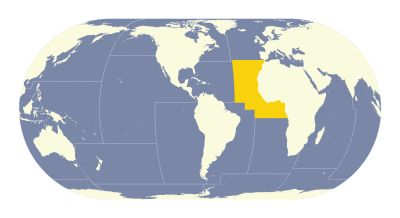 | Figure B4.1 The Eastern Central Atlantic (Area 34)  |
Water Area Overview  | | Water Area Overview Marine resources - Eastern Central Atlantic
| fao Major | 34: Atlantic, Eastern Central |
| | | | | | Water Area Overview |
Water Area OverviewMarine resources - Eastern Central Atlantic Aq Res Struct Biological Stock: Biological Stock Exploit The fisheries in Area 34 are diverse, and many of them are typically multispecies, thus posing additional challenges for assessment and management. The type of fishing vessels used ranges from small-scale dugout canoes, through larger motorized canoes and coastal fleets to large industrial fleets of national or distant-water origin. These distantwater vessels mostly come from Europe and Asia. The catches from national fleets have gradually increased since the 1950s. In comparison, the distant-water fleet catches have been fluctuating, based on changes in legal regimes regulations and market forces. In the late 1980s, changes in Eastern Europe first resulted in the appearance of a number of new distant-water fishing nations that started operating in Area 34. Subsequently, increased emphasis placed on market forces and changes in management regimes resulted in a reduction in the activities of some distant-water fleets that were mainly targeting small pelagic fishes. Since 1996, fishing effort by EU fleets on small pelagics has increased in the northwest portion of Area 34. Although there have been some fluctuations, catches have remained high since that time. Other foreign fleets are also active in Area 34, targeting small pelagics, large pelagics (tuna), shrimp, cephalopods and demersal fish. The proportion of catches originating from the artisanal fisheries has varied over time and also by subregion. Information obtained from various working group reports of the Fishery Committee for the Eastern Central Atlantic (CECAF) indicate that in the northern part of Area 34 (north of Guinea-Bissau), the percentage of catches originating from the artisanal fisheries are lower than the percentage in the southern part of Area 34.
Despite the variety of fisheries in Area 34, catches are dominated by small pelagics, especially sardine (Sardina pilchardus) and other clupeids (ISSCAAP Group 35). The highest catches are taken in the northern part of Area 34. The group accounted for about 43 percent of total nominal catches in 2009 as compared with just over 50 percent in 2002 (FAO, 2005). The fleet exploiting these resources includes artisanal canoes, national coastal and industrial vessels and foreign industrial vessels. PROFILE OF CATCHESThe total nominal catches reported from Area 34 increased almost twelvefold from about 300 000 tonnes in 1950 to close to 3.6 million tonnes in 1977. Since then, catches have oscillated between 2.5 million tonnes in 1979 and the peak of 4.1 million tonnes recorded in 1990. This variation appears to be due to changes in markets, fishing effort, and environmentally-induced changes that have affected stock productivity. Catches of ISSCAAP Group 35 species have shown the largest fluctuations. From 1998 to 2007, catches showed an overall decreasing trend, followed by an increase in 2008 and 2009. The catches in 2009 of 3.6 million tonnes equalled that of the average for the period 1998–2009 (Figure B4.2 and Table D4).
The major contributors to catches in Area 34 are the species of ISSCAAP Group 35 (herrings, sardines and anchovies). They account for more than 40 percent of the total catch reported (Figure B4.2). The landing of this group increased slightly to 1.8 million tonnes in 2009 compared with 1.5 million tonnes in 2007. 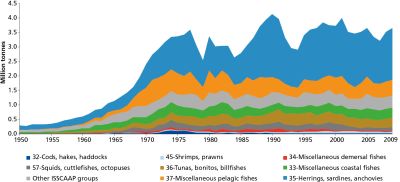 | Figure B4.2 Annual nominal catches by ISSCAAP species groups in the Eastern Central Atlantic (Area 34)  |
Distant-water fishing fleets, mainly catching small pelagics and tunas, have made large but irregular contributions since the early 1970s. In the late 1960s and in the 1970s, these fleets dominated the catches. However, the coastal States steadily developed their national fisheries, increasing their contribution from 43 to 72 percent of total catches in Area 34 between 1977 and 2002. Since 2003, coastal States have contributed between 75 and 80 percent of the catches (Figure B4.3). 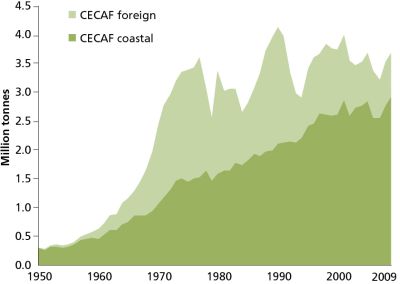 | Figure B4.3 Annual nominal catches by coastal States and foreign fleets, Eastern Central Atlantic (Area 34)  |
Four species categories account for more than 80 percent of the catches in ISSCAAP Group 35 (herrings, sardines, anchovies, etc.). The European pilchard, also known as sardine (Sardina pilchardus), makes the largest contribution followed by the round sardinella (Sardinella aurita), the bonga shad (Ethmalosa fimbriata), the European anchovy (Engraulis encrasicolus) and the flat sardinella (Sardinella maderensis). Sardinella spp. also account for a sizeable portion of the group total (Figure B4.4). 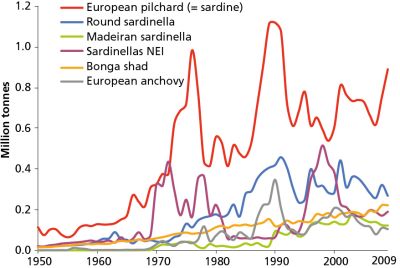 | Figure B4.4 Annual nominal catches of selected species in ISSCAAP Group 35, Eastern Central Atlantic (Area 34)  |
Trachurus spp. are the dominant species group in ISSCAAP Group 37 (miscellaneous pelagic fishes) (Figure B4.5). Their catches increased sharply in the late 1960s, remained high throughout most of the 1970s, but declined through most of the 1980s and 1990s. Since the late 1990s the catches of this species group have been fluctuating widely, with an average of about 240 000 tonnes for the period 2000–09.
The main Trachurus species in Area 34 are the Atlantic horse mackerel (Trachurus trachurus), found mainly to the very north of Area 34, and the Cunene horse mackerel (Trachurus trecae), found along the coast in the tropical and subtropical regions. Few countries report to species level and most catches are reported at higher levels (Figure B4.5 and Table D4). Large catches of another important species, Chub mackerel (Scomber japonicus), were made in two exceptional years in 1988–89. This period was followed by a collapse of the catches in 1993, a recovery in 1997 and fluctuations since then, with an average of about 190 000 tonnes for the period 2000–09. Catches in 2009 were about 180 000 tonnes, slightly lower than the average for the last decade. 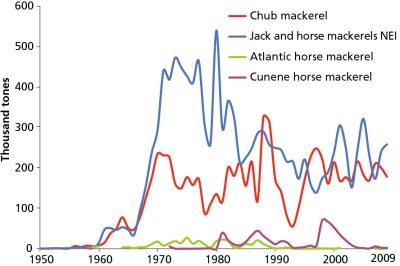 | Figure B4.5 Annual nominal catches of selected species in ISSCAAP Group 37, Eastern Central Atlantic (Area 34)  |
The catches from ISSCAAP Group 36 (tunas, bonitos, billfishes, etc.) show similar trends with time for the main species (Figure B4.6). The two main species are skipjack (Katsuwonus pelamis) and yellowfin tuna (Thunnus albacares). Catches of skipjack generally surpassed yellowfin tuna catches from 1991 onwards, with the exception of 2002 when yellowfin catches were slightly higher. The 2009 catches of these species were 125 000 tonnes for skipjack and about 95 000 tonnes for yellowfin. Catches of bigeye tuna have been about 40 000 tonnes since 2002. 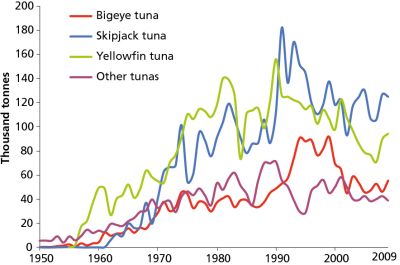 | Figure B4.6 Annual nominal catches of selected species in ISSCAAP Group 36, Eastern Central Atlantic (Area 34)  |
Senegalese hake (Merluccius senegalensis) has been the major contributor to ISSCAAP Group 32 (cods, hakes, haddocks), with catches above 100 000 tonnes in the 1970s. Catch decreased to about 20 000 tonnes in the 1980s and remaining relatively steady at this lower level of catches until 2001, after which the catches declined (FAO/CECAF, forthcoming a, forthcoming b). With the exception of 2009, catches of European hake (Merluccius merluccius) have exceeded the catches of Senegalese hake since 2002 (Figure B4.7). 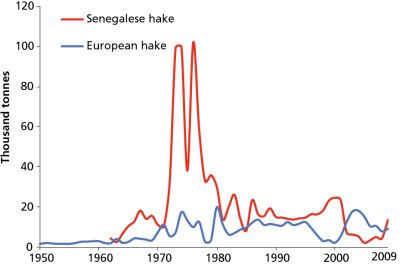 | Figure B4.7 Annual nominal catches of selected species in ISSCAAP Group 32, Eastern Central Atlantic (Area 34)  |
Figure B4.8 shows the main species catches in ISSCAAP Group 45 (shrimp and prawns). Southern pink shrimp (Penaeus notialis) catches started to become significant in the 1960s showing a general increasing trend, with oscillations, reaching a peak of 33 000 tonnes in 1999.
This was followed by a continued decline until 2004 and catches have remained at about 13 000–14 000 tonnes ever since. Catches of non-identified Penaeus shrimps have been about 3 000–5 000 tonnes since 2004. The deepwater rose shrimp (Parapenaeus longirostris) fishery started in 1972 and catches have been variable since then, with a high of 19 000 tonnes in 1978. The most recent peak was observed in 1998, when deepwater rose shrimp catches of 12 000 tonnes were reported from the region. Catches then decreased to 6 000 tonnes in 2000 and further to 1 500 tonnes in 2004. Since then catches have remained low and, in 2009, catches of 500 tonnes were reported to FAO.  | Figure B4.8 Annual nominal catches of selected species in ISSCAAP Group 45, Eastern Central Atlantic (Area 34)  |
Figure B4.9 shows the reported catches from ISSCAAP Group 57 (squids, cuttlefishes, octopuses).
The octopus (Octopus vulgaris) fishery in the region dates back to the 1950s. Catch reporting of this species started in 1962 to reach 93 000 tonnes in 1975, but catches have since regularly decreased to reach 9 000 tonnes in 2002 and 8 000 tonnes in 2009. However, the observed decrease in catch of the common octopus is not necessarily an indication of non-availability but could also be related to how it is reported in the catches. The group “Octopuses NEI” has shown a generally increasing trend, albeit with large interannual fluctuations up to 1993. From 1993 to 1998, catches in this category decreased followed by a record high recorded in 1999 of 150 000 tonnes. Catches dropped after this to 36 000 tonnes in 2004 before increasing to 74 000 tonnes in 2009.
Catches of cuttlefish have fluctuated with an average of 46 000 tonnes from 1986 to 2004. After 2004 (the peak of the series), catches decreased until 2007 reaching 25 000 tonnes in 2008. Catches in 2009 were 33 000 tonnes. Catches of squids have also decreased since the mid-1990s, and the average catch since 2000 is 8 000 tonnes compared with 23 000 tonnes for the period 1990–99. 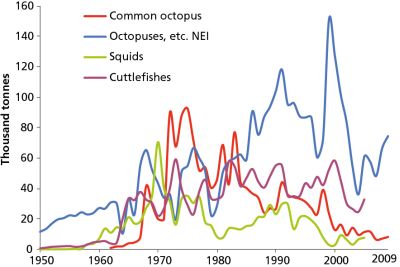 | Figure B4.9 Annual nominal catches of selected species in ISSCAAP Group 57, Eastern Central Atlantic (Area 34)  |
Management Management: Management Many of the countries in the region do not have well-developed management systems in place. Only a few countries have management plans or regular scientific monitoring of the main resources. Research capacity to evaluate the state of stocks and their exploitation is also not always well developed. There are varying underlying causes for this, including human, institutional and financial capacity issues. Many of the main fishery resources in the region are shared among countries, posing additional challenges for the management of the fisheries exploiting these resources. Difficulties in MCS occur throughout the region. Illegal, unreported and unregulated fishing is a common phenomenon in Area 34. Nevertheless, there are several regional and national initiatives currently ongoing that are aiming to assist countries in addressing some of these key challenges for fisheries management. Sources Marine and Inland Fisheries Service, Fisheries and Aquaculture Resources Use and Conservation Division. FAO Fisheries and Aquaculture Department “Review of the state of world marine fishery resources” FAO FISHERIES AND AQUACULTURE TECHNICAL PAPER. No. 569. Rome, FAO. 2011.  http://www.fao.org/docrep/015/i2389e/i2389e.pdf http://www.fao.org/docrep/015/i2389e/i2389e.pdf Bibliography The bibliographic references are available through the hyperlink displayed in "Source of Information". |
|
| |
|
|





